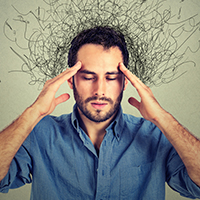at least 2.5 percent of the population will experience OCD at some point in their lives

OCD, or obsessive compulsive disorder, was once thought to be a rare mental health condition. Recent studies, however, have found that at least 2.5 percent of the population will experience OCD at some point in their lives.1
OCD is a condition that is cyclical and causes great stress and anxiety. A person with this condition has obsessive thoughts; these cause anxiety, and the person then uses compulsive behaviors to reduce that anxiety. The behavior may provide temporary relief, but the obsessions return. To get relief requires treatment guided by mental health professionals.
According to the fifth and most recent edition of the Diagnostic and Statistical Manual of Mental Disorders (DSM), obsessive compulsive disorder is diagnosed when a person has obsessions, compulsions, or both, that are excessive, time-consuming, distressing and interfere with work, school responsibilities or social life. The two main factors in OCD are obsessions and compulsions:
OCD was previously categorized as a type of anxiety disorder, but in the latest edition of the DSM it leads a new category of related conditions that includes body dysmorphic disorder, trichotillomania (compulsive hair-pulling) and other related illnesses.
To be diagnosed with OCD a person must exhibit either obsessions or compulsions, or both.2 He or she will try to cope with those obsessions by suppressing them, ignoring them or using compulsions to stop them. The compulsions must be excessive and used with the express purpose of relieving anxiety or stopping the obsessive thoughts, although they cannot rationally be expected to stop these thoughts.
A diagnosis can be made only if these obsessions and compulsions take up more than an hour per day or cause significant impairment in a person’s life, such as disruption when socializing or when at work or school. The obsessions and compulsions also cannot be attributable to substance abuse or another mental health condition if OCD is to be diagnosed.
Nearly anything can be an obsessive thought for a person with OCD, and anything can become a compulsive behavior. It may not be similar at all to the obsessions, or it may be connected by a related theme. For example, a common obsession for someone with OCD is germs and being exposed to them. A related compulsion is to wash the hands frequently and excessively. Other examples of more common obsessions include:
Examples of compulsions that are more common include:
Keep in mind that these behaviors by themselves are normal, but when they are repeated in excess and to reduce stress or manage obsessive thoughts, they become problematic.
Call now to be connected with one of our friendly, helpful admissions specialists.
Recognizing OCD in oneself is not always easy, but there are some signs that may indicate an internal struggle with obsessions and compulsions that could be diagnosed as OCD. These include:
Obsessive compulsive disorder interferes with a person’s activities and life, so some of the signs of the condition are indirect. For instance, a person with OCD may start performing poorly at school or work. The condition may cause this person to become withdrawn and to socialize less. There may be disruptions in personal relationships as the person tries to hide compulsions or obsessive thoughts. A person may engage in alcohol or drug abuse as a way to relieve the anxiety of obsessions.
Someone with OCD may also experience tics3, brief and repetitive motions. These may include eye movements or blinking, facial movements, shoulder shrugs, sniffling, throat clearing or unusual sounds, like grunting.
It may be more difficult to recognize signs of OCD in school-age children, but there are some clues that may indicate a child is struggling with this issue4: